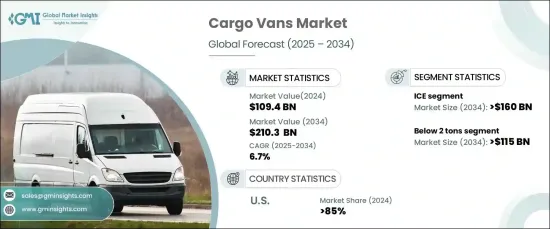
카고 밴 세계 시장 규모는 2024년 1,094억 달러로 평가되며 2025년부터 2034년까지 연평균 6.7%로 성장할 것으로 예상되며, E-Commerce 및 관련 물류 업무의 급속한 확장은 이러한 차량에 대한 수요를 촉진하고 있습니다. 온라인 쇼핑에 대한 소비자의 선호도 증가와 빠른 배송 서비스의 부상으로 소매, 식품 배송, 헬스케어 등 산업 전반의 성장이 더욱 가속화되고 있습니다. 도시화와 인구 밀도의 증가는 요구 사항을 변화시켜 혼잡한 도시를 이동하는 데 적합한 더 작고 민첩한 차량의 개발로 이어지고 있습니다. 또한, 환경 규제를 충족하고, 연료 효율을 높이고, 배기가스를 줄이기 위해 제조업체는 전기 및 하이브리드 기술을 도입하여 시장이 현대 도시 물류에 적응할 수 있도록 하고 있습니다.

추진력 측면에서는 내연기관차(ICE)가 우세하여 2024년 시장 점유율의 80% 이상을 차지했습니다. 이 분야는 2034년까지 1,600억 달러가 넘을 것으로 예상됩니다. 작고 효율적인 디젤 및 가솔린 엔진의 발전은 터보 과급 및 정밀 연료 분사 시스템 등의 혁신 기술과 함께 성능을 향상시키고 있습니다. 마일드 하이브리드 및 플러그인 시스템과 같은 하이브리드 기술도 인기를 끌고 있습니다. 이러한 시스템은 ICE와 전기 모터를 결합하여 에너지 효율을 향상시키고, 배출가스를 줄이며, 파워와 지속가능성의 균형을 최적화하는 시스템입니다.
| 시장 범위 | |
|---|---|
| 시작 연도 | 2024년 |
| 예측 연도 | 2025-2034년 |
| 시작 금액 | 1,094억 달러 |
| 예상 금액 | 2,103억 달러 |
| CAGR | 6.7% |
카고 밴은 톤수에 따라 2톤 미만, 2-3톤, 3톤 이상으로 분류되며, 2톤 미만 부문은 2034년까지 1,150억 달러를 넘어설 것으로 예상됩니다. 전기화는 이 카테고리의 성장을 촉진하는 주요 요인으로, 제조업체들은 경량 배터리, 효율적인 모터, 첨단 에너지 관리 시스템을 개발하여 도시 배송 및 단거리 용도에 대응하고 있습니다. 향상된 배터리 기술은 더 긴 주행거리와 빠른 충전이 가능하여 라스트 마일 배송 및 지방 자치 단체의 차량 운영에 이상적인 밴이 될 수 있습니다. 어댑티브 크루즈 컨트롤, 레인 어시스트, 자동 브레이크와 같은 안전 기능은 업무 효율성과 차량 관리를 개선하기 위해 점점 더 많이 통합되고 있습니다.
미국은 엄격한 환경 규제와 기업의 지속가능성 추진으로 2024년 매출 점유율의 85% 이상을 차지했습니다. 전기 밴은 운영 비용 절감, 배기가스 배출 감소, 정부의 인센티브 제공으로 인해 선호도가 높아지고 있습니다. 유럽은 냉장 운송 및 이동식 작업장 등의 용도로 사용할 수 있는 모듈식 및 맞춤형 설계에 초점을 맞추고 있습니다. 반면, 아시아태평양은 중소기업과 기업가들을 위한 다용도적이고 저렴한 디자인으로 비용에 민감한 시장을 공략하고 있습니다. 첨단 제조 기술은 품질을 유지하면서 생산 비용을 절감하는 데 도움이 되며, 이러한 차량이 도시와 농촌 지역 모두에서 다양한 운영 요구 사항을 충족할 수 있도록 돕습니다.
The Global Cargo Vans Market was valued at USD 109.4 billion in 2024 and is expected to grow at a CAGR of 6.7% from 2025 to 2034. The rapid expansion of e-commerce and associated logistics operations is driving demand for these vehicles. Increasing consumer preference for online shopping and the rise of fast delivery services are further fueling growth across industries like retail, food delivery, and healthcare. Urbanization and higher population density are reshaping requirements, leading to the development of smaller, more agile vehicles suited for navigating congested cities. Additionally, manufacturers are incorporating electric and hybrid technologies to meet environmental regulations, enhance fuel efficiency, and reduce emissions, enabling the market to adapt to modern urban logistics.

In terms of propulsion, internal combustion engine (ICE) vehicles dominate, accounting for over 80% of the market share in 2024. This segment is projected to surpass USD 160 billion by 2034. Advancements in compact and efficient diesel and gasoline engines, along with innovations like turbocharging and precision fuel injection systems, are enhancing performance. Hybrid technologies, such as mild-hybrid and plug-in systems, are also gaining traction. These systems combine ICEs with electric motors to improve energy efficiency and reduce emissions, offering an optimized balance between power and sustainability.
| Market Scope | |
|---|---|
| Start Year | 2024 |
| Forecast Year | 2025-2034 |
| Start Value | $109.4 Billion |
| Forecast Value | $210.3 Billion |
| CAGR | 6.7% |
Cargo vans are further categorized based on tonnage capacity into below 2 tons, 2-3 tons, and above 3 tons. The below 2 tons segment is expected to exceed USD 115 billion by 2034. Electrification is a major factor driving growth in this category, with manufacturers developing lightweight batteries, efficient motors, and advanced energy management systems to cater to urban delivery and short-range applications. Enhanced battery technology is enabling longer ranges and faster charging, making these vans ideal for last-mile delivery and municipal fleet operations. Safety features like adaptive cruise control, lane assistance, and automated braking are increasingly integrated to improve operational efficiency and fleet management.
The US accounted for over 85% of the revenue share in 2024, driven by stringent environmental regulations and the push for corporate sustainability. Electric vans are gaining traction due to lower operational costs, reduced emissions, and government incentives. Europe is focusing on modular and customizable designs, enabling applications like refrigerated transport and mobile workshops. Meanwhile, the Asia Pacific region is targeting cost-sensitive markets with versatile and affordable designs that cater to small businesses and entrepreneurs. Advanced manufacturing techniques are helping reduce production costs while maintaining quality, ensuring these vehicles meet diverse operational needs in both urban and rural settings.